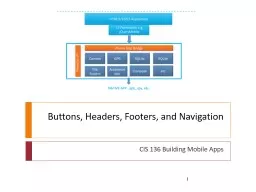PPT-Lab 6 Buttons and Debouncing
Author : stefany-barnette | Published Date : 2018-09-21
Finite State Machine 1 Lab Preview Buttons and Debouncing Mechanical switches bounce vibrations cause them to go to 1 and 0 a number of times called chatter
Presentation Embed Code
Download Presentation
Download Presentation The PPT/PDF document "Lab 6 Buttons and Debouncing" is the property of its rightful owner. Permission is granted to download and print the materials on this website for personal, non-commercial use only, and to display it on your personal computer provided you do not modify the materials and that you retain all copyright notices contained in the materials. By downloading content from our website, you accept the terms of this agreement.
Lab 6 Buttons and Debouncing: Transcript
Download Rules Of Document
"Lab 6 Buttons and Debouncing"The content belongs to its owner. You may download and print it for personal use, without modification, and keep all copyright notices. By downloading, you agree to these terms.
Related Documents














